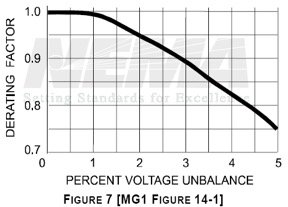Motors are expensive and essential. We've defined these standards of motor protection:
Motors can be damaged or destroyed under any of the following conditions:
Low or high supply voltage
Phase unbalance
Continuous excessive loading
Single-phasing
Jam or stall conditions
Ground/earth faults
Mechanical failures such as seized motor bearing or binding mechanical linkages
Industry standards to consider when defining motor protection requirements:
Overload trip Classes are defined by industry standard and affect the time to trip once an overload condition is realized. NEMA trip classes 5, 10, 20 and 30 indicate the time (seconds) to affect the trip of a motor operating at 600% of rated load.
Class 5 is typically used motors requiring extremely fast tripping.
Class 10 is commonly used to protect artificially cooled motors such as submersible pumps of low thermal capacity.
Class 20 is typically sufficient for general purpose applications.
Class 30 is typically required for high inertia loads to prevent nuisance tripping.
NEMA MG-1, 12.44; AC motors shall operate successfully under running conditions at rated load with a variation in the voltage or the frequency up to the following.
Plus or minus 10% of rated voltage with rated frequency for induction motors.
Plus or minus 5% of rated frequency with rated voltage.
A combined variation in voltage and frequency of 10% of the rated values, provided the frequency variation does not exceed plus or minus 5% of rated frequency.
NEMA MG-1, 12.45; AC polyphase motors shall operate successfully under running conditions at rated load when the voltage unbalance does not exceed 1%.
NEMA MG-1, 14.36; When the line voltages applied to polyphase induction motor are not equal, unbalanced currents in the stator windings will result. A small percentage of voltage unbalance will result in a much larger percentage current unbalance. These unbalanced voltages will result in unbalanced currents on the order of 6 to 10 times the voltage unbalance. Consequently, the temperature rise of the motor operating at a particular load and voltage unbalance will be greater than for the motor operating under the same conditions with balanced voltages. In addition, the large unbalance of the motor currents will result in nonuniform temperatures in the motor windings.
Operation of a motor above 5% voltage unbalance is not recommended. Even at 5% voltage unbalance, motor current unbalance on the order of 40% can exist. Should voltages be unbalanced, the motor horsepower should be de-rated per figure 14-1.
Motors must be de-rated to avoid the damages caused by small amounts of phase imbalance. Phase voltage imbalance should be less than 1% for proper motor function.
For every 10˚ C rise in temperature, insulation life and value is roughly halved.
The percent temperature rise in windings can be calculated as [ 2 x (voltage imbalance)2 ]
IEEE 1159 defines typical power disturbances in Table 2. Both short and long duration power quality issues are typically less than 1 minute in duration. Parameter setpoints, particularly fault time delays, may be reduced from factory defaults to improve protection.


The following examples denote the significance of imbalance and heat rise as it relates to motor protection:
Per NEMA, a voltage imbalance of 5% results in a motor output derating of 25%. For example, 100HP would be derated to a 75HP. The resulting heat rise would be 50%.
A voltage imbalance of as little as 3% results in a motor output derating of 10%, and a heat rise of 18%.
A motor with insulation rated at 155 C, having an engineered life cycle of 40,000 hours, would have a 20,000-hour life expectancy operating at 165 C.
Do your motor overload relays provide the level of protection associated with these standards?
If you're not using advanced motor protection relays, then you are not protecting your motors to these standards. EECO can help you identify advanced protection relays that will work for you.
Contact the Power and Control team for your motor protection solutions or schedule time with the Connected Power Lab!









